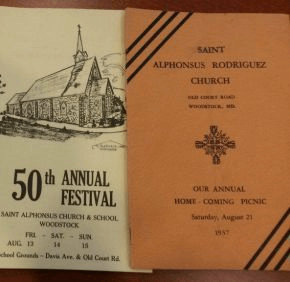By Paul McMullen
pmcmullen@CatholicReview.org
Twitter: @ReviewMcMullen
WOODSTOCK – Luke 9:16 had the loaves and the fishes.
St. Alphonsus Rodriguez Parish has a mountain of corn that needs shucking.
“We go through 75 dozen ears of corn each day,” Stephanie Porta said. “It comes in at 11 a.m., and I’ll fret about it being shucked. Next thing you know, there are 20 people in a circle, doing the work. I call it our field of dreams.”
Porta runs the kitchen at the parish’s annual Woodstock Festival, which will celebrate its 100th edition Aug. 8 and 9.
What started in 1916 as a homecoming picnic for Jesuits who had studied at the old seminary linked to the parish has endured a series of post-Vatican II calamities and thrives, thanks to the volunteers Porta described, all led for decades by Barbara Helmrich.
“So many people really put their heart and soul into the festival,” said Jesuit Father Joseph P. Lacey, pastor. “St. Alphonsus is unique in my experience in that there is no pettiness, people protecting their own turf or sniping at what others are doing. It’s a remarkable parish with a wonderfully generous, collaborative spirit.”
The parish lies less than a mile north of the Patapsco River, where Baltimore County becomes Howard, which supplies most parishioners.
The nearby town of Granite was named for the stone quarried to build the original church in the late 1880s. Prior to that, the community had worshipped at the College of Woodstock, the Jesuit seminary, since their joint founding in 1869.
As the other Woodstock Festival attracted hundreds of thousands to upstate New York for peace, love and music in 1969, St. Alphonsus Rodriguez faced trying times.
In 1968, its original church was destroyed in a fire. A year later, its parish school closed, and in 1970 Woodstock College moved to New York.
Jerry Curran was baptized and served as a sacristan in the old church; attended the parish school, Little Flower (not to be confused with the one in Belair-Edison); and worked as a busboy at the seminary, now a Job Corps Center.
“This was rural country,” said Curran, who attended Mount St. Joseph High School in Irvington and later taught and coached there. “Otherwise, I hitch-hiked everywhere I went. Sometimes, I’d wait 20 minutes for a car to pass. We called it the August festival back then, from the corn harvest.”
…
It used to last three days, and include a shooting gallery where prizes included packs of cigarettes. This year’s main raffle is for a luxury car. It used to be for a steer donated from the family farm operated by the late George Strohmer Sr., who had been a lector, Sunday School teacher and member of the parish’s Holy Name Society.
Other traditions remain, such as adhering to the typed recipe for its signature fried chicken, using the kiddie “train” frames built by the late Emerson Feaga and keeping the majestic maple that sits between the church and rectory a center of attention.
“We brought back bingo under the tent,” Porta said. “When we moved it into the parish center, it dwindled.”
Besides, the parish center is taken over by diners and Attic Treasures, the flea market that brought in more than $6,000 last year, nearly one quarter of the $25,000 the festival netted for the parish.
“It used to be in Father Lacey’s garage, and it really ramped up after the parish center opened in 2005,” Mindi Lawton said. “(Volunteers) love to price and organize items. If we have bad weather, it does real well.”
In addition to organizing Attic Treasures, Lawton directs the parish pre-school, where children soak up that spirit of giving.
“Kids 12 and over can serve meals,” she said. “A couple of years ago a boy told me that ‘a family gave me a $5 tip, and I put it in the poor box.’ That feeling, of giving back, is everywhere.”
Also see:
Warming hearts, hearth at St. Alphonsus


